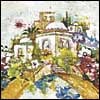The Extent of Damage Necessary to Disqualify the Stones of the Altar and the Beis HaMikdash
In Hilchos Beis HaBechirah 1:14, the Rambam states:
Whenever a stone has become damaged to the extent that one’s fingernail would become caught in it [when passing over], it is disqualified for [use in] the altar and the ramp, as is the case regarding a slaughtering knife. For it is written,1 “You shall build the altar of G‑d with whole stones.”
In halachah 15, the Rambam mentions a similar law: “Stones from the Sanctuary or the courtyards2 which were damaged or split are disqualified for use.” One might assume that the same measure, a nick large enough for one’s fingernail to be caught in it, applies in this instance as well. Although the Rambam does not mention this explicitly, it can be explained that his purpose is to avoid redundancy, for the concept was stated in the previous halachah.
There are, however, commentaries3 which differ and maintain that in the latter context, the Rambam’s intent is that a leniency is granted, and a greater blemish is necessary to disqualify the stone. As support, they cite our Sages’ statement,4 that the stones of the First5 Beis HaMikdash were hewn out by the shamir, a wormlike creature that was miraculously able to chew through stone. The Rabbis6 explain that stones hewn by the shamir would never be utterly smooth. Nicks large enough for a fingernail to be caught on them would always remain.7
In halachah 16, the Rambam continues and mentions related subjects, stating, “When a stone was damaged... after it was built into the altar or the ramp, that stone alone is invalidated. The others are still fit for use.”
It is possible to explain that, in this halachah as well, the Rambam was relying on the measure he mentioned in halachah 14. Indeed, Rashi and other commentaries8 do not differentiate between the size of a nick which would disqualify a stone before it is used for the altar (halachah 14) and after it is included in the altar (halachah 16). Nevertheless, according to the opinion that the Rambam is speaking of a different measure in halachah 15, it would appear necessary for him to specify his intent in halachah 16.
The necessity for such clarification is further emphasized by the prooftext cited by the Rambam in halachah 14: “You shall build the altar of G‑d with whole stones.” For one might suppose that different laws apply before “you shall build the altar,” and once that altar has already been built.9
An Abstract Conception
These difficulties can be resolved by analyzing the intent of the Rambam in the phrase, “to the extent that one’s fingernail would become caught in it.” There are opinions10 which explain that this refers to the smallest possible measure. Even the slightest nick is sufficient to disqualify a knife from being used for ritual slaughter or a stone from being used for the altar.
According to this view, the question arises: Why doesn’t the Rambam use the expressioniKol She'hu, the term which is usually employed to refer to a measure of the smallest possible size?
The answer is that abstractly, there is a difference between the two concepts. Even the opinions which explain that the phrase “to the extent that one’s fingernail would become caught in it” refers to the smallest possible measure, it is still referring to a blemish that can be measured and calibrated in a physical sense. Such a blemish is significant, for, to refer to the point under discussion, any blemish, however small, prevents a stone for the altar from being “whole.”
Kol She'hu, by contrast, is a totally abstract point, referring to the essence of the existence of a substance. To cite an example:11 “It is forbidden to benefit from wine which was offered as a libation to a false deity. A person who drinks Kol She'hu of such [wine] is [punished by] lashing.” The intent is not that the person becomes liable when he drinks a significant measure, and that in this case even the slightest amount is significant. Rather, it is the very fact that he drinks from the wine at all which makes him liable.12The quantity is not important, merely the fact that he drinks.
The Difference between a Stone to be used for the Altar and One which is already Part of the Altar
To apply this concept to the stones of the altar: Before a stone is used for the altar, it must be whole. The smallest possible blemish, “to the extent that one’s fingernail would become caught in it,” is sufficient to disqualify it. The reason for the disqualification is, however, because a significant blemish has been made.
Once a stone has been used for the altar, a different conception applies. If the stone is blemished — and what is important here is the fact that it has been blemished and not the size of the blemish — it is disqualified, and indeed, the entire altar is unfit until the stone is replaced.
What is the reason for this distinction? As the Rambam indicates in halachah 17, there is a prohibition against damaging the stones of the altar, those of the Sanctuary, and those within the courtyard of the Beis HaMikdash.13 That prohibition is derived from the verses:14 “Do away with all the places where the nations... worship their gods.... Destroy their altars.... Do not do so to G‑d, your L‑rd.”
The derivation of the prohibition against destroying the portions of the Beis HaMikdash from a verse concerning the worship of false divinities, establishes a connection between them. The worship of false divinities contaminates every dimension of the entities associated with them. Therefore, it is written:15 “Let nothing which has been condemned cling to your hand.” tuva kf, any and all traces of connection to the false deities, is forbidden. Similarly, in regard to the Beis HaMikdash, making even the slightest blemish in its structure is forbidden.16
On this basis, we can differentiate between the Rambam’s ruling in halachah 14 and his rulings in halachos 15 and 16. In halachah 14, the Rambam is speaking of a stone with which one intends to build the altar. This stone must be whole and if it is damaged “to the extent that one’s fingernail would become caught in it,” it may no longer be used.
In halachos 15 and 16, the Rambam is not relying on the measure he stated previously, or granting a more lenient measure as had been suggested originally. Instead, because he is speaking about stones that have already been used for the Beis HaMikdash, he is referring to a more stringent measure. Because of the parallel to the worship of false divinities,Kol She'hu, even the slightest blemish, disqualifies the stone.17
The Lasting Effects of an Act of Destruction
There is, however, a slight difficulty with the above conception. The prohibition mentioned in halachah 17 refers to an act committed by a person with a willful, destructive intent. In contrast, the disqualification of the stones mentioned in halachos 15 and 16 refers even to circumstances where the damage to the stones come about through forces beyond man’s control.
This difficulty can, however, be resolved as follows: Damaging a stone of the altar or the Beis HaMikdash is not merely a forbidden activity, it affects the sanctity of these entities as well. This is reflected in the Rambam’s ruling18 that when a person damages a stone in the altar, the holiness of the altar is temporarily nullified and does not return until the damaged stone is replaced. Thus we see that the emphasis of the above-mentioned prohibition is not only on the act of destruction performed by the person,19 but on the destructive effect produced within the altar and the Beis HaMikdash.20 It follows that even if a similar effect is produced by forces beyond man’s control, the sanctity of the altar and the Beis HaMikdash is, nevertheless, impaired.
To be part of G‑d’s Chosen House
The requirement that the stones of the altar remain “whole” reflects the unique nature of the Beis HaMikdash — that it is the Beis HaBechirah, “[G‑d’s] Chosen House.” As explained in chassidic thought,21 G‑d’s choice is free and unconditioned, coming as a result of His will, without being influenced at all by the virtues of the entity He chooses. For were the virtues of the entity able to influence G‑d’s choice, that would imply that they have power over Him, heaven forbid.
As a corollary, it follows that G‑d’s choice is not at all dependent on an the size or measure of an entity. And this leads to a further point. When the importance of an entity is dependent on its positive virtues, if there is an impairment in the virtues, the effect is quantitative, dependent on the extent of the damage done. When, by contrast, the importance of an entity is dependent on G‑d’s choice, the effect of damage to a portion of that entity is not quantitative.
To relate these points to the above discussion: As explained above, if even the slightest amount of damage is done to the stones of the altar or the Beis HaMikdash, they are disqualified. Their importance comes because they are part of “[G‑d’s] Chosen House,” and He has stated that a stone which is damaged cannot be part of this structure. Accordingly, what is significant is the fact that they have been damaged, even if the damage is tuva kf, and not the extent of the damage.
* * *
May we merit the day when all the damage to G‑d’s Chosen House will be repaired with the building of the Third Beis HaMikdash, the structure where His choice will be manifest in a complete sense. And may this take place in the immediate future.
Adapted from Likkutei Sichos, Vol. XXIX, Ki Savo







Start a Discussion